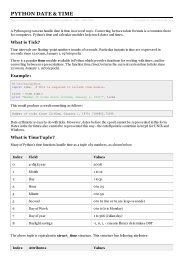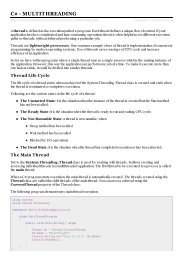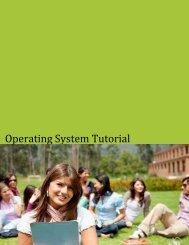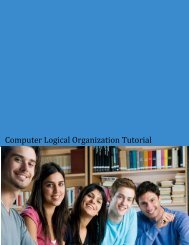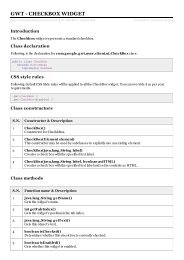Download Scala Tutorial (PDF Version) - Tutorials Point
Download Scala Tutorial (PDF Version) - Tutorials Point
Download Scala Tutorial (PDF Version) - Tutorials Point
Create successful ePaper yourself
Turn your PDF publications into a flip-book with our unique Google optimized e-Paper software.
CHAPTER<br />
1<br />
<strong>Scala</strong> Overview<br />
<strong>Scala</strong>, short for <strong>Scala</strong>ble Language, is a hybrid functional programming language. It was created by Martin<br />
Odersky and it was first released in 2003.<br />
<strong>Scala</strong> smoothly integrates features of object-oriented and functional languages and <strong>Scala</strong> is compiled to run on the<br />
Java Virtual Machine. Many existing companies, who depend on Java for business critical applications, are turning<br />
to <strong>Scala</strong> to boost their development productivity, applications scalability and overall reliability.<br />
Here is the important list of features, which make <strong>Scala</strong> a first choice of the application developers.<br />
<strong>Scala</strong> is object-oriented:<br />
<strong>Scala</strong> is a pure object-oriented language in the sense that every value is an object. Types and behavior of objects<br />
are described by classes and traits which will be explained in subsequent chapters.<br />
Classes are extended by subclassing and a flexible mixin-based composition mechanism as a clean<br />
replacement for multiple inheritance.<br />
<strong>Scala</strong> is functional:<br />
<strong>Scala</strong> is also a functional language in the sense that every function is a value and because every value is an object<br />
so ultimately every function is an object.<br />
<strong>Scala</strong> provides a lightweight syntax for defining anonymous functions, it supports higher-order functions, it<br />
allows functions to be nested, and supports currying. These concepts will be explained in subsequent chapters.<br />
<strong>Scala</strong> is statically typed:<br />
<strong>Scala</strong>, unlike some of the other statically typed languages, does not expect you to provide redundant type<br />
information. You don't have to specify a type in most cases, and you certainly don't have to repeat it.<br />
<strong>Scala</strong> runs on the JVM:<br />
<strong>Scala</strong> is compiled into Java Byte Code, which is executed by the Java Virtual Machine (JVM). This means that<br />
<strong>Scala</strong> and Java have a common run-time platform. You can easily move from Java to <strong>Scala</strong>.<br />
TUTORIALS POINT<br />
Simply Easy Learning







